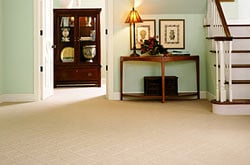A Carpet Installation Primer
See if We Have Top-Rated
Carpet Installers in Your Area

Quality carpet installation is critical to ensuring you'll enjoy the feel, look, and optimal performance of your new carpet for years to come. A successful installation requires a number of things, from preparation on down to post-installation procedure. Here's a short list of how to be certain your new carpet installation is a successful one.
Perform Other Home Improvement Projects First!
It's not uncommon for those putting in new carpet or other flooring to suddenly notice their living room needs a new paint job or that the master bedroom could use a little wallpaper to bring it up to par with the new floor. Try to anticipate these possible companion projects before you install your carpet. Why? Painting, wallpapering, and most other home improvement projects are messy jobs. Better to spill a gallon of paint on the carpet headed for the dumpster rather than the new stuff you just bought.
Prep the Area
Once your other projects are completed, it's time to get ready for the new carpet. Removing all furniture and thoroughly vacuuming the area to be carpeted is a great first step. If you're having the carpet removed by your carpet installers, your job is pretty much over. If you're doing the work yourself, or are removing the carpet before your carpet installers show up in order to cut down on costs, remove the carpet and then vacuum the subfloor as well.
Prepare the Subfloor
Most pre-existing subfloors will be ready to go once you've swept, vacuumed, and cleaned them up. If you've got large cracks in your subfloor, however, you or your contractor will need to seal and level them before laying carpet. And certain materials, especially those with a glossy finish such as vinyl sheet, vinyl tiles, and painted floors, will need to roughed-up or removed before the carpet is put down if you're using adhesives.
Ready for some better floors? Use this link to
Install Carpet
Lay the Padding and Carpet
Once you've covered all your bases, it's time to put down the padding and the carpet. Sounds easy, but there's a few things to keep in mind before things get rolling, the most important of which is the best installation procedure for you.
Final Steps
After your installation is complete, you'll notice you'll be vacuuming up loose fibers for a few days. Don't worry. That's normal and will go away after a few rounds with the vacuum cleaner. Also, you're sure to notice a chemical smell, especially if your carpet was installed with adhesive. As a remedy, ventilate the room for 48-72 hours after the installation complete, until that "new carpet smell" is gone.
Finally, talk to certified carpet installers or retailers to get the latest on carpet styles, colors, and other options, and to get your new carpet installation underway. Whether you try to install carpet on your own, or have them do it for you, they're an excellent resource when it comes to making sure your carpet installation gets done right.
More Tips & Advice For Your Home
- Related Articles
- Recent Articles

